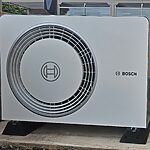@derek-m, from what I can see, you can connect the second circulating pump and an internal temperature sensor to the broad in the unit, speak to your installer or the merchant where the unit came from. Your best performance will be if you remove the circulating pump, change the buffer and move the controller.
I do not install the midia units as I do not like the way they work.
The nest is a basic on-off thermostat, it is not intelligent, it is as good as a light switch.
The heat pumps sensor is a thermocouple which communicates the actual room temperature to the unit and the unit modulates the compressor, flow temperature and pump flow rate to maintain the temperature in the property.
Heat pumps are not fossil fuel boilers, they are not a simple fire in a box. They are very complex, complicated pieces of equipment and have to be treated correctly if the best performance is going to be achieved, they are very unforgiving, if designed, installed and operated correctly, they give many years of trouble free, efficient operation, if not they can be a nightmare.
If I understand you, what you are saying is:
1. Nest controller/TRVs + no weather compensation - the ASHP works like a simple ff boiler. All it has to control it are its ouput flow temperature setting and the return flow temperature it senses.
2. Nest controller/TRVS + weather compensation - as above but also uses outside temperature to vary its output flow temperature
3. Your suggestion - as 2. above but also uses inside temperature.
Is that right? What I'm missing is how the ASHP varies its power output in addition to simply when it switches on/off. Are you saying that in 1. it will just work at full power until the defined output flow temperature is reached, switch off and repeat? Is 2. the same or will it do something cleverer based on the extra input of outside temperature? For 3., I think you are saying that the ASHP will modulate its flow temperatures, pressures, compressor, etc. based on flow, indoor and outside temperatures.
This must vary with model/age of ASHP? I have mine (Mitsubishi) set up as it was installed, using weather compensation and its own wireless thermostats and the compressor definitely varies in how fast it's running. Does it (and others similar) communicate indoor temperature to the ASHP and use it to modulate as you describe?
So I just called Freedom Heat Pumps, who supplied the unit. They said that the controller isn't really any more efficient than another thermostat as it will just do the same thing as the Nest; call for heat. They said it is slightly more efficient, but really much.
Likewise for temperature they said I can adjust it down for a higher COP and they set it where they do so most customers have "warm radiators" to the touch. They guy said he would expect the best performance (COP) being at 40 degrees in our house as it has radiators and UFH.
Given how warm our house is, I think I'll keep playing with the temperatures until I get the right mix. Can't do this until it gets colder the heating actually comes on though. Even with this current weather our main room is still 23 when we get up all on its own.
@batalto I have that manual and others, yours should be piped as per page 4 for best performance
@batalto, no problem, you can listen to them and do what you are doing or try what I am saying and significantly reduce your running costs. The simple fact of a heat pump is that high temperature = high bills.
Hi Batalto,
What Heacol is proposing will probably give more efficient operation of your ASHP system during the Winter heating period. It may also do so during the Spring and Autumn periods to a lesser extent. Much depends on the heat losses, size of heat emitters and operating parameters of the ASHP.
A good analogy would be that you have to drive a car 120 miles in 2 hours, so if you drive at a constant 60 m.p.h. you will reach your destination in the allotted time. If you now make the return journey, but have to stop for 5 minutes every 25 miles, you would have to increase your average speed to 68.6 m.p.h. to arrive back on time. Also, instead of accelerating from 0 to 60 m.p.h. once, you would need to accelerate from 0 to 68.6 m.p.h. four times, and probably use slightly more fuel at the higher speed.
When a heat pump starts, like a car, it uses more energy until it reaches balanced operating conditions, also if it has to provide the same amount of heat energy over a shorter period of time, it will need to make the water flow temperature higher.
Running a ASHP for longer periods, but at lower temperatures, should equate to lower overall energy consumption and lower costs.
The main problem is how to reasonably accurately control the operation of the system under varying operating conditions, particularly in Spring and Autumn when the heating may not be required during daytime but is required overnight.
Even modern thermostats like the Nest are still on - off devices, and also cause temperature variations due to their operating deadband, the difference in temperature between them switching on and switching off.
Whilst the Midea controller should provide smoother overall temperature control, I am still not certain how it would cope with large houses with numerous rooms without there being temperature differences.
@derek-m it's actually not really an issue for us. Our "main room" is a massive 12m x 6m and as such basically requires all of the heating effort. We use TRVs in the other rooms and a separate zone upstairs to keep them the right temperature. However the upstairs heating is rarely used, only on the very coldest days due to super high insulation in the top of the house.
I think I might just pop the Midea controller through the wall into the main room and move the Nest upstairs. Otherwise I could just set the Nest to 22° on the basis it will never get there and would that would then run the ASHP all the time and then tweak the flow temperature compensation to hold 21°
Hi Batalto,
You could set your system to operate as you suggest, though it would mean that your central heating pump would be running all the time and hence increase your energy usage and costs. That is assuming that your Nest thermostat switches your central heating pump on and off. Does it also start and stop your ASHP.
Prior to moving your Midea controller I would suggest setting your weather compensation so that it produces a water temperature of 25C when the ambient air temperature is 15C, and a water temperature of 50C when the ambient air temperature falls to -10C. Ensure that weather compensation is on and then increase the setpoint of your Nest to start the system. With the system running, see what the water temperature from the ASHP settles at. If the system operates as I expect, the water temperature should be 25C if the ambient air temperature is 15C or above, and should increase by 1C above 25C for each 1C that the ambient air temperature falls below 15C.
Tests and observations I made on my own system over the Winter period indicated that a 1C fall in ambient air temperature required approximately a 1C increase in water temperature to maintain the indoor temperature at the desired level.
- 26 Forums
- 2,381 Topics
- 54 K Posts
- 331 Online
- 6,065 Members
Join Us!
Worth Watching
Latest Posts
-
Hi, Just wondering is there any app on my phone i can...
By newhouse87 , 3 minutes ago
-
RE: Installer Fitted 9kW Instead of 11kW Heat Pump and Changed MCS Paperwork - What do I do?
Well, no major progress to report as yet. HIES replied ...
By MairiA , 10 minutes ago
-

This thread looks fun, and I'm now wondering if changin...
By Steelbadger , 38 minutes ago
-

RE: Solar Power Output – Let’s Compare Generation Figures
You're right @bash - every G99 application gets assesse...
By Transparent , 45 minutes ago
-
Advice for a novice on Mitsubishi Ecodan 6kW
Hello all, I am very much hoping to draw on the e...
By Green_Fox , 1 hour ago
-
RE: Advice on Vaillant Sensocomfort
@jamespa Hi Jamespa, I have all of those - A SensoComfo...
By dr_dongle , 1 hour ago
-
RE: Recommended home battery inverters + regulatory matters - help requested
It's not actually essential that your inverter and batt...
By Bash , 2 hours ago
-
RE: Say hello and introduce yourself
Thanks @jamespa. Much appreciated. I've read that Intro...
By Green_Fox , 2 hours ago
-
RE: Insulating a pitched roof with kingspan, has anyone done it?
As you have maximum floor insulation, there will be lit...
By AgentGeorge , 4 hours ago
-

RE: New Fogstar 15.5kWh upright solution
Erm... how can @jancold post new links? It's you @bat...
By Transparent , 4 hours ago
-
RE: Octopus Cosy Heat Pump Owners & Discussion Thread
You are doing well in January. Dec COP with my Vaillan...
By JamesPa , 5 hours ago
-
RE: Gen 6 Samsung ASHP losing 20C of DHW in 60 min directly after generation
That was what confused me! The heat pump FT is doing w...
By JamesPa , 7 hours ago
-

@renewables345 — thank you for the clarification. I'm r...
By cathodeRay , 7 hours ago
-
RE: Connecting Growatt SPH5000 over wired ethernet rather than wireless
Well well well.. turns out my WiFi dongle is actually t...
By z8lccda , 19 hours ago
-
RE: Solis S6-EH1P8K-L-PLUS – Why I Chose It and What I’ve Learned So Far
I am now considering adding a second battery to my setu...
By Batpred , 21 hours ago
-

@abam48 Did you go for this option and does it work wel...
By dgclimatecontrol , 23 hours ago
-
RE: Weather compensation- why you should use it
Okay thanks both. Yes the house is very nic...
By jamesh , 1 day ago
-
RE: Cascade 2x Grant Areona 10kw ASHP - Ongoing setup issues
Well this morning the master bedroom & ensuite were...
By adam , 1 day ago
-

RE: Setback savings - fact or fiction?
That is correct, the setback period was Feb to Apr 2025...
By cathodeRay , 1 day ago
-
RE: Havenwise App Help & Forum Support – Get the Most from Your Heat Pump
Fair enough. The reason for asking was that Henri's po...
By Sheriff Fatman , 1 day ago




